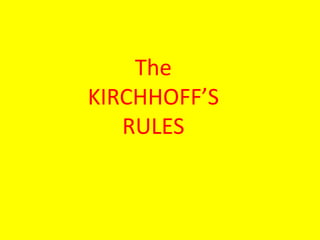
Kirchh
- 1. The KIRCHHOFF’S RULES
- 2. Introduction Kirchhoff’s rules Types of Kirchhoff’s rules Junction rule Example of Junction rule Loop rule Example of Loop rule Sign Convention (Kirchhoff”s rule) Uses of Kirchhoff’s rules TOPICS
- 3. Introduction Most electrical circuit consist not merely a single source and a single external resistor, but comprise of a number of sources, resistors or other elements such as capacitors, motors etc. interconnected in a complicated manner. The general term applied to such a circuit is called a network In this presentation, we will discuss how Kirchhoff’s Rule are based on charge neutrality in a metal which will greatly help in calculating electrical properties.
- 4. KIRCHHOFF’S RULES We know that :- 1/R=1/R1 + 1/R2 + 1/R3 +………+ 1/Rn
- 5. This uses the fact that there is no net current at any junction . The potential difference across any resistor is same that is if we complete the circuit XY -> YX via a path involving any two resistors, the total potential change is 0. These facts, are called Kirchhoff’s Rules which are very useful for many circuit problem.These rules are given by Gustav Kirchhoff in 1845.
- 6. Junction rule It states that “at any junction of several circuit elements, The sum of currents entering the junction must equal the sum of currents leaving it.” This rule is based on the fact that change can’t accumulate at any point in a conductor in a steady situation. Net positive or negetive charge will accumalate at the junction at a rate equal to the net electrical current at the junction.
- 7. EXAMPLE OF JUNCTION RULE In this figure, the currents directed towards junction are:- I 1 ,I 2 , -I 3 and -I 4 . So, I 1 + I 2 +(-I 3 ) +(-I 4 )=0 Charges pass through point. So,net charge coming towards point should be equal to that going away from it in same time.
- 8. LOOP RULE It states that “The algebraic sum of changes in potential around any closed resistor loop must be zero.” This rule is based on energy conservation. Otherwise,one can continuously gain energy by circulating charge around a closed loop in a particular direction . The net charge of all potential differences should be zero.
- 9. EXAMPLE OF LOOP RULE While using this rule, one starts from a point on the loop and goes along the loop, either clockwise or anti- clockwise, to reach the same point again. Any potential drop encountered is taken to be positive and any potential rise is taken to be negative.
- 10. The sum of all potential differences should be zero. As we start from A and go along the loop clockwise to reach the same point A,we get the following potential differences: VA – VB = -I1 R1 VB – VC = -I2 R2 VC – VD = - E1 VD – VE = I3 R3 VE – VF =-I4 R4 VF – VA = E2
- 11. Adding all these, 0= I 1 R 1 + I 2 R 2 – E1 + I 3 R 3 – I 4 R 4 + E2 The loop will follow the fact that the work done by it in any closed path is zero.
- 12. SIGN CONVENTION IN APPLYING KIRCHHOFF’S RULES The principal difficulty in these rules is not in understanding basic ideas but in keeping track of algebraic signs.
- 13. GUIDELINES HELPING IN SOLVING PROBLEMS ARE:- 1.Choose any closed loop in the network, and designate a direction (clockwise or counter clockwise) to transverse the loop in applying the loop rule.
- 14. 2 . Go around the loop in the designated direction, adding emf’s and potential differences. An emf is counted as positive when it is traversed from (-) to (+)and negative when transformed from (+) to (-). An IR term is counted negative if the resistor is traversed in same direction of the assumed current, and positive if in opposition direction.
- 15. 3. Equate the sum of step (2) to zero . 4 . If necessary, choose another loop to obtain different relations between the unknowns .
- 16. continue until there are as many equations and unknowns or until every circuit element has been included in at least one of the chosen loops.
- 17. USES OF KIRCHHOFF’S RULES To determine currents in different parts of closed loop : JUNCTION RULE: ∑l= 0 (at any junction) LOOP RULE: If directions of travel and current are SAME, the sign of “IR” is(-). If directions of travel and current are opposite,then sign of “IR” is(+).
- 18. To determine potential difference between any 2 points in loop. Travel from any one point in the circuit to the other, the potential difference between them will be :- = ∑ E + ∑ IR, as applied on the cells and resistances between these points.
- 19. Thank you
- 20. Done By M.Rama Krishna
- 21. Guided by G.PrasadaRao PGT PHYSICS